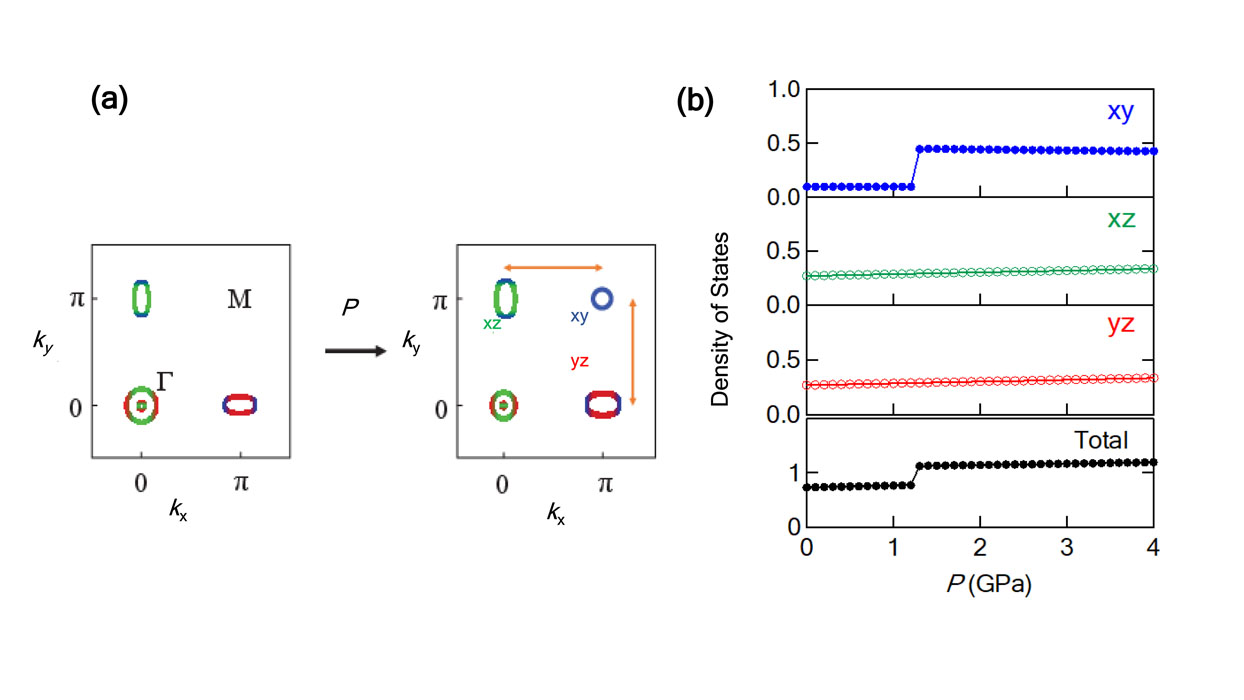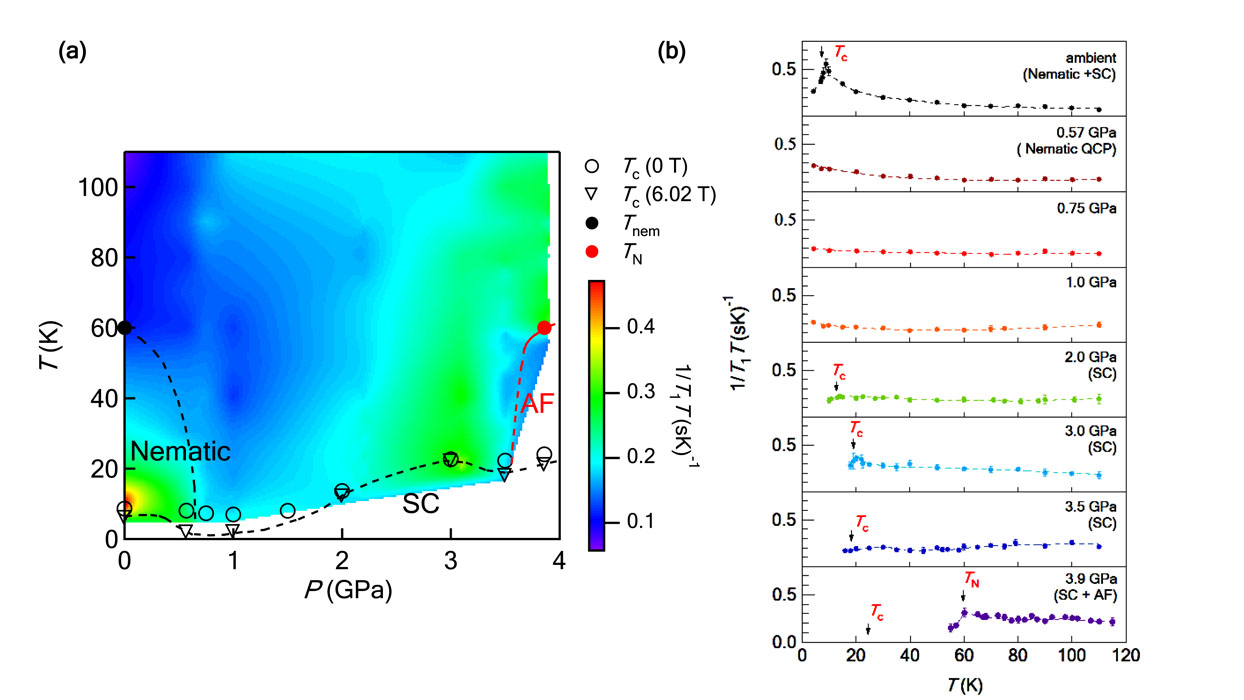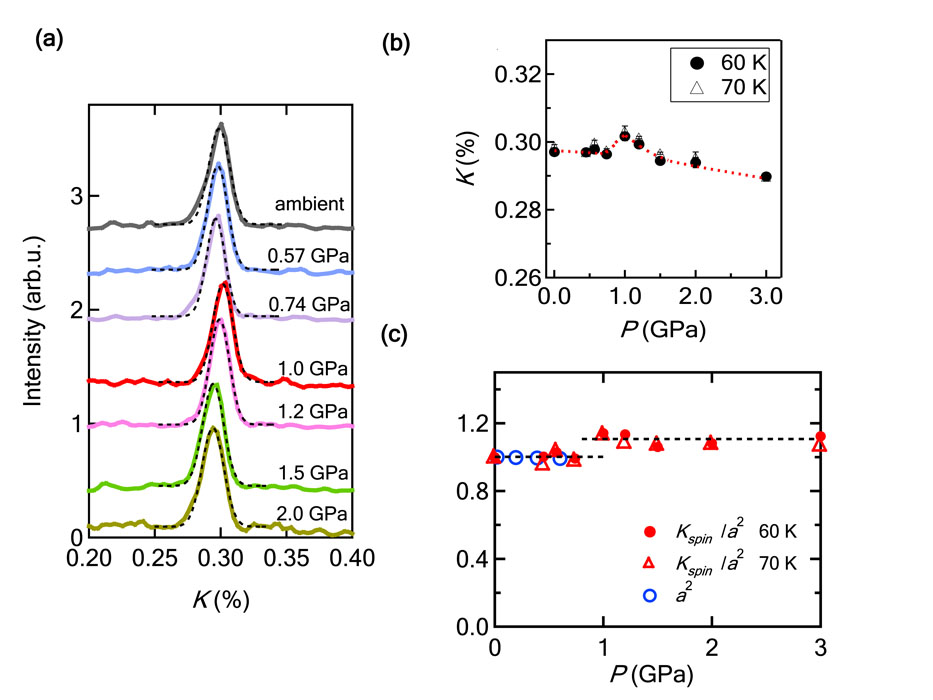Pressure-Induced Lifshitz Transition Observed from Nuclear Magnetic Resonance in S-Substituted FeSe
PI of Joint-use project: N. FujiwaraHost lab: Uwatoko Group
We performed 77Se-nuclear magnetic resonance (NMR) measurements under pressures of up to 3.9 GPa on 12 % S-substituted FeSe and observed a pressure-induced Lifshitz transition at around 1.0 GPa from the Knight shift (K) and relaxation rate (1/T1) [1].
FeSe is unique among iron-based superconductors in the point that small unconnected Fermi surfaces induce superconductivity without magnetism. The left panel of Fig. 1(a) shows the Fermi surfaces in the tetragonal phase. The Fermi surfaces consist of the small hole pockets at point Γ, k = (0, 0), and anisotropic electron pockets at point X, k = (π, 0) or (0, π) [2-4]. The superconductivity appears in the nematic phase where four-fold rotational symmetry is broken. Unlike iron-based pnictides, this orbital configuration reduces the likelihood of nesting between electron and hole pockets with the same orbital, leading to the absence of magnetism.

Fig. 1. (a) Schematic Fermi surfaces of pure FeSe in a tetragonal phase theoretically derived at ambient pressure and high pressure. The Fermi surfaces colored in green, red, and blue represent dxz, dyz, and dxy orbitals, respectively. Arrows indicate the nesting of dxy orbitals between points M and X. (b) The density of states (DOS) originating from each orbital and the total DOS calculated theoretically for 10% S-substituted FeSe.
Upon pressure application, FeSe undergoes an antiferromagnetic (AF) order instead of the nematic order [5]. Although the nematic and AF phases are complicatedly entangled in the pressure versus temperature (P-T) phase diagram, S substitution makes possible to resolve the complex overlap between them [6].
Figure 2(a) shows the P-T phase diagram for 12% S-substituted FeSe determined from ac susceptibility and 77Se-NMR measurements [1]. A single crystal with dimensions of approximately 1.0mm × 1.0mm × 0.5mm was used for these experiments. Figure 2(b) shows 1/T1T for the field parallel to the FeSe plane. The color plot in Fig. 2(a) obtained from 1/T1T provides a measure of low-energy spin fluctuations. As seen from the color plot, AF fluctuations below and above 1 GPa are of different origins. Strong AF fluctuations develop without magnetism in the nematic phase below 1 GPa, whereas AF fluctuations seem to be weak above 1 GPa despite of the AF-phase boundary.

Fig. 2. (a) Color plot of relaxation rate divided by temperature (1/T1T). The superconducting (SC) phase shows a double-dome structure at 6.02 T. TCs shown by circles and inverted triangles are determined from AC susceptibility measurements at 0 T and 6.02 T, respectively. Both nematic and SC orders are absent at 1.0 GPa at 6.02 T. (b) T dependence of 1/T1T measured at 6.02 T for the field parallel to the FeSe plane. TCs shown by arrows are the same with those in Fig. 2(a).
The anomaly at 1 GPa is also observed in the shift K. The NMR spectra at 60 K and K at 60 and 70 K are shown in Fig. 3(a) and 3(b), respectively. The shift is decomposed as K = Korb + Kspin where Kspin and Korb represent the spin and orbital parts, respectively. The former and latter are T-dependent and T-independent, respectively. The orbital part Korb is ~0.26% at low pressures below 1 GPa and decreases 0.005 and 0.01 % at 2 and 3 GPa, respectively. The decrease at high pressures is estimated from the decrease in Kspin due to superconductivity [1]. The spin part Kspin and the uniform susceptibility χ(0) are related to Kspin = Aχ(0) where A is the hyperfine coupling. Since χ(0) can be described using the density of states (DOS) of a 2D free electron system, Kspin is expressed as Kspin ∝(Na)2m/ħ where N2, a, and m are the total number of lattices, lattice constant, and electron mass, respectively. Two quantities, Kspin /a2 and a2, normalized by those at ambient pressure are shown in Fig. 3(c).

Fig. 3. (a) Pressure dependence of the NMR spectra at 60 K. Each spectrum is fitted with a Gaussian function, as indicated by dotted curves. (b) Pressure dependence of the Knight shift (K) measured at 60 and 70 K. The dotted curves are guides to the eye. (c) Pressure dependence of the spin part of K divided by a2 (Kspin/a2) where a represents the square of the a-axis lattice constant. In the figure, Kspin/a2 and a2 are normalized by those at ambient pressure. The dashed lines represent the average of Kspin/a2 at pressure regions below and above 1 GPa. The results in Fig. 3(c) are comparable to theoretical calculations in Fig. 1(b).
The step-like enhancement of Kspin /a2 at 1 GPa implies the appearance of other Fermi surfaces, as expected theoretically at high pressures [4] (See the right panel of Fig. 1(a)). The results of Kspin /a2 are comparable to the theoretically calculated total DOS shown in Fig. 1(b). The Fermi surface at point M, k = (π, π), is of dxy-orbital origin, leading to the nesting with unconnected Fermi surfaces with the same dxy orbital (See yellow arrows in Fig. 1(a)). In fact, the enhancement of Kspin /a2 seems to be smaller than that shown in Fig. 1(b), implying that the size of the hole pocket at the point M is fairly small. This unbalanced nesting would induce very weak AF fluctuations observed at high pressures above 1 GPa.
In conclusion, we performed 77Se-NMR measurements on 12% S-substituted FeSe under pressures of up to 3.9 GPa. We observed the anomalies of K and 1/T1T corresponding to the theoretically predicted Lifshitz transition. Our results suggest that the emergence of the dxy orbital and its orbital-selective coupling play a key role to understand the electronic properties of FeSe at high pressures.
References
- [1] T. Kuwayama, et al., Scientific Reports 11, 17265 (2021).
- [2] M. D. Watoson, et al., Phys. Rev. B 91, 155106 (2015).
- [3] L. Fanfarillo, et al., Phys. Rev. B 97, 121109 (2018).
- [4] Y. Yamakawa, et al., Phys. Rev. B 96, 144509 (2017).
- [5] J. P. Sun, et al., Nat. Commun. 7, 12146 (2016).
- [6] K. Matsuura, et al., Nat. Commun. 8, 1143 (2017).
